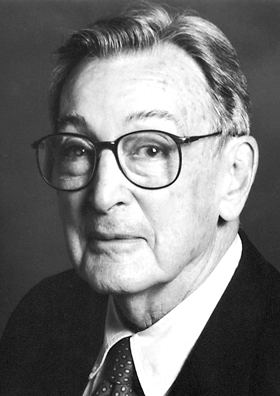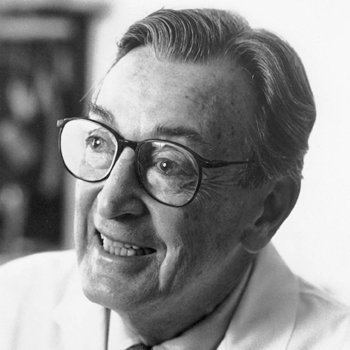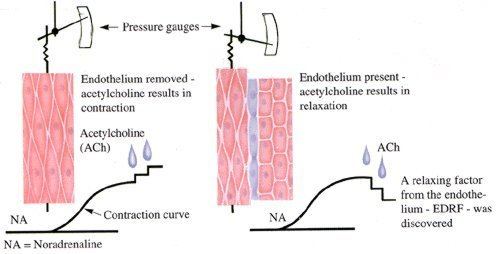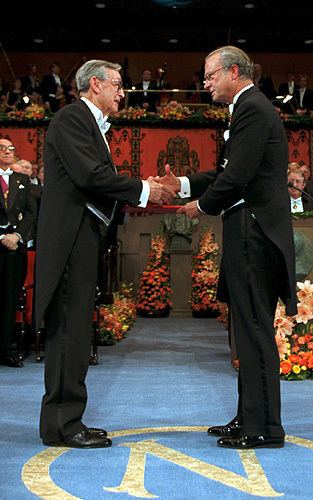Citizenship American Nationality United States | Name Robert Furchgott | |
 | ||
Institutions SUNY Downstate Medical Center 1956–2009Washington University in St. Louis 1949–1956Cornell University 1940–1949 Spouse Lenore Mandelbaum (1941–1983; her death; 3 children)Margaret Gallagher Roth (?–2006; her death) Education University of South Carolina, Northwestern University, University of North Carolina at Chapel Hill Similar People Ferid Murad, Louis Ignarro, Earl Wilbur Sutherland - Jr | ||
The Robert F. Furchgott Society 2019 Visiting Professorship Lecture | Edvard Moser, Ph.D
Robert Francis Furchgott (June 4, 1916 – May 19, 2009) was a Nobel Prize-winning American biochemist who contributed to the discovery of nitric oxide as a transient cellular signal in mammalian systems.
Contents
- The Robert F Furchgott Society 2019 Visiting Professorship Lecture Edvard Moser PhD
- Dr Robert F Furchgotts 20th Anniversary Celebration Reception Gala
- Early life and education
- Career
- Personal life
- References

Dr. Robert F. Furchgott's 20th Anniversary Celebration Reception Gala
Early life and education

Furchgott was born in Charleston, South Carolina, to Arthur Furchgott (December 1884 – January 1971), a department store owner, and Pena (Sorentrue) Furchgott. He graduated with a degree in chemistry from the University of North Carolina at Chapel Hill (1937), and went on to earn a Ph.D in biochemistry at Northwestern University (1940), immediately joining a medical faculty thereafter.
Career

Furchgott was faculty member of Cornell University Medical College from 1940 to 1949, of Washington University School of Medicine from 1949 to 1956, and State University of New York Downstate Medical Center from 1956 to 2009, as professor of pharmacology.

In 1978, Furchgott discovered a substance in endothelial cells that relaxes blood vessels, calling it endothelium-derived relaxing factor (EDRF). By 1986, he had worked out EDRF's nature and mechanism of action, and determined that EDRF was in fact nitric oxide (NO), an important compound in many aspects of cardiovascular physiology. This research is important in explaining a wide variety of neuronal, cardiovascular, and general physiologic processed of central importance in human health and disease.
In addition to receiving the Nobel Prize in Physiology or Medicine for the discovery of nitric oxide as a new cellular signal—shared in 1998 with Louis Ignarro and Ferid Murad —Furchgott also received a Gairdner Foundation International Award (1991) for his groundbreaking discoveries, and the Albert Lasker Award for Basic Medical Research (1996), the latter also with Ferid Murad.
Personal life
Furchgott, who was Jewish, lived for most of his married and career life in Woodmere, NY (Long Island). He was married to Lenore Mandelbaum (February 1915 – April 1983) from 1941 until she died aged 68. They had three daughters: Jane, Terry and Susan. His daughter, Susan, was a prolific artist in the San Francisco counter culture and a co-founder of the Kerista Commune (she was also known as "Even Eve" and "Eve Furchgott"). Robert Furchgott spent his later years with Margaret Gallagher Roth, who died March 14, 2006. He served as a professor emeritus at the State University of New York Downstate Medical Center. In 2008 he moved to Seattle's Ravenna neighborhood. Furchgott died on May 19, 2009 in Seattle. He is survived by his three daughters, four grandchildren, and three great-grandchildren.
